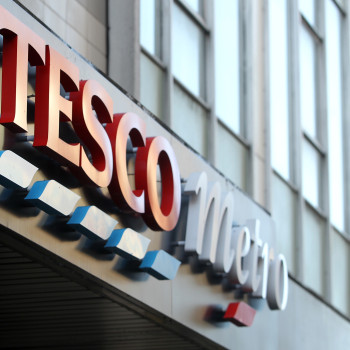More pain to come for squeezed middle market

The drastic measures announced by its new chief executive Dave Lewis demonstrate the scale of the problems facing Tesco, Britain and Ireland’s largest retailer. However, it is becoming clear that most of Tesco’s competitors are also facing similar problems as consumers increasingly opt for the discounters and the internet. Dan White reports
15 January 2015
When Dave Lewis was drafted in as Tesco chief executive last July, the first outsider to head the company in its 96-year history, it was already clear that the company faced major problems. Just how severe those problems were became clear when Tesco issued its Christmas trading statement earlier this month.
Tesco announced that it is to close 43 of its existing UK stores and to scrap plans to open another 49 new stores. It is closing its defined benefit pension scheme – making it one of the last large employers to do so. Dunnhumby, the analytics business that manages Tesco’s Clubcard loyalty scheme, is to be put up for sale. The final dividend is to be scrapped. Capital expenditure is to be halved to £1bn a year. And as if all of this wasn’t enough to be getting on with, Tesco is cutting its central costs by 30% or £250m a year.
Somehow one can’t help feeling that if the kitchen sink had been close at hand, Mr Lewis would have announced that he was throwing it out also.
Loses are lessening
However, there was at least a glimmer of hope that the trading statement represented the nadir of Tesco’s fortunes. While Tesco’s UK same store sales fell by 2.9% in the 19-week period to 3 January, this was still an improvement on the disastrous 5.4% sales decline recorded in the second quarter of 2014. Even better news for Tesco is that UK same store sales fell by “only” 0.3% during the six-week Christmas period.
Tesco’s Irish operation was not immune from the downturn. While Tesco’s Irish performance figures are buried in its European figures, it also experienced a sales decline in this country. Same store Christmas sales were down by 5.5% at Tesco Ireland.
Tesco is not alone
While Tesco’s competitors would hardly be human if they didn’t feel at least a hint of schadenfreude at their rival’s discomfiture, it is becoming increasingly clear that the difficulties at Tesco reflect deeper-rooted problems affecting all of the major grocery retailers on these islands. Tesco is not alone, far from it.
A recent report by estate agents CBRE calculated that the UK supermarket chains, Sainsbury’s, Asda and Morrisons as well as Tesco, are sitting on approximately 1,000 acres of development land. However, only 6% of this land is currently being built upon. The implication of the report is clear: supermarkets will never be built on much of this land and the retail chains will have to drastically write-down its value.
In an interview published in The Telegraph newspaper last month Sir Ian Cheshire, the former chief executive of Kingfisher – best known in this country as the owner of B&Q, likened the predicament of Tesco and its UK rivals to that of the big DIY chains a decade ago. He predicted that the UK food retailers would be forced to scrap up to 20% of their floor space, a process that will take several years and necessitate huge property write-downs.
Further evidence that Tesco’s problems are not unique came when some of the other UK retailers published their Christmas trading figures. Worst of the lot was easily Marks & Spencer, whose same store UK sales were down 2.7% while same store sales dropped by 1.2% at Sainsbury’s.
Underestimating the Germans
It is now crystal clear that both the UK food retailers and their Irish counterparts initially massively underestimated the competitive threat represented by the German discounters Aldi and Lidl. While the established retailers were continuing to build enormous, sometimes more than 100,000 square feet, out-of-town superstores, more and more customers were doing their shopping at the discounters whose average floor size is less than 15,000 square feet.
The fact that the discounters typically stock less than 2,000 lines versus the more than 50,000 lines stocked by the out-of-town superstores seemed not to matter at all as shoppers increasingly opted for price and convenience over choice. The evidence of the marketplace is irrefutable with the latest Kantar Worldpanel figures showing the discounters hold up to 8.3% of the UK market and 16.2% of the Irish market.
Getting internet shopping wrong
At the same time as they were underestimating the competitive threat posed by the discounters, most of the established UK and Irish food retailers were also getting their internet offering terribly wrong. Unlike books or clothes, which aren’t perishable, or better still music, film, air travel or e-books, where there is no physical delivery, food is different. Just try delivering fresh meat or dairy products a couple of days late.
Getting the logistics of home delivery right is frighteningly complex – and expensive – with some analysts calculating that each UK home delivery costs Tesco up to £20. There is no way that consumers will pay the charges necessary to recover those sort of costs. This means that while click and collect – where the consumer orders and pays for his or her groceries online but collects them from the store – probably has a future, home delivery will almost certainly turn out to be an expensive turkey.
Further fragmentation to come
So what does all of this mean for Tesco and the other established UK and Irish food retailers? The grocery market is going to continue to fragment. Apart from Aldi and Lidl, the other big winner in the UK grocery market in recent years has been Waitrose, the oh so posh food arm of John Lewis, which saw its same store Christmas sales jump 2.8%. Maybe Musgrave should resurrect the Superquinn fascia?
While the top and bottom of the grocery market has been growing, the middle is being relentlessly squeezed. This isn’t going to change any time soon. Despite the positive market reaction to the Tesco announcement, with the share price jumping 15%, its problems aren’t over yet, not by a long shot.
The future for Tesco and the other mid-market food retailers is likely to be years of grinding retrenchment as they seek to purge the excesses of the past and adapt to a new, leaner future.



 Print
Print




Fans 0
Followers